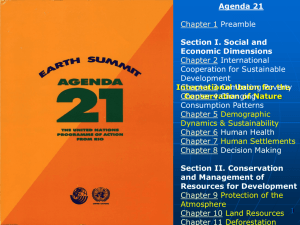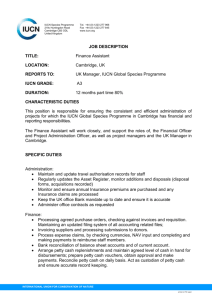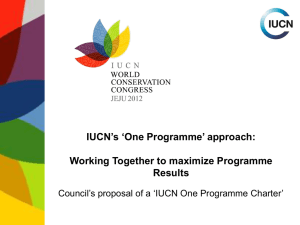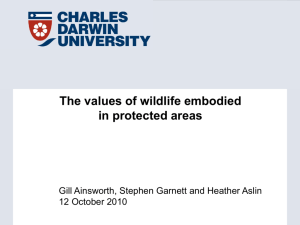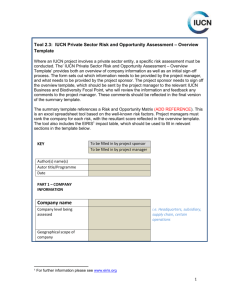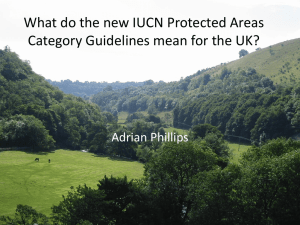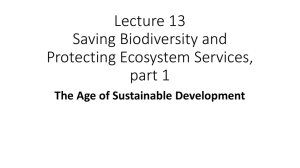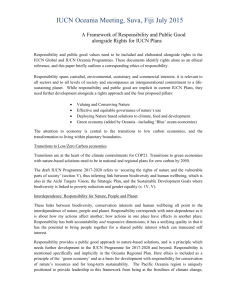ANNUAL REPORT: June 1, 2012 – May 31, 2013
advertisement
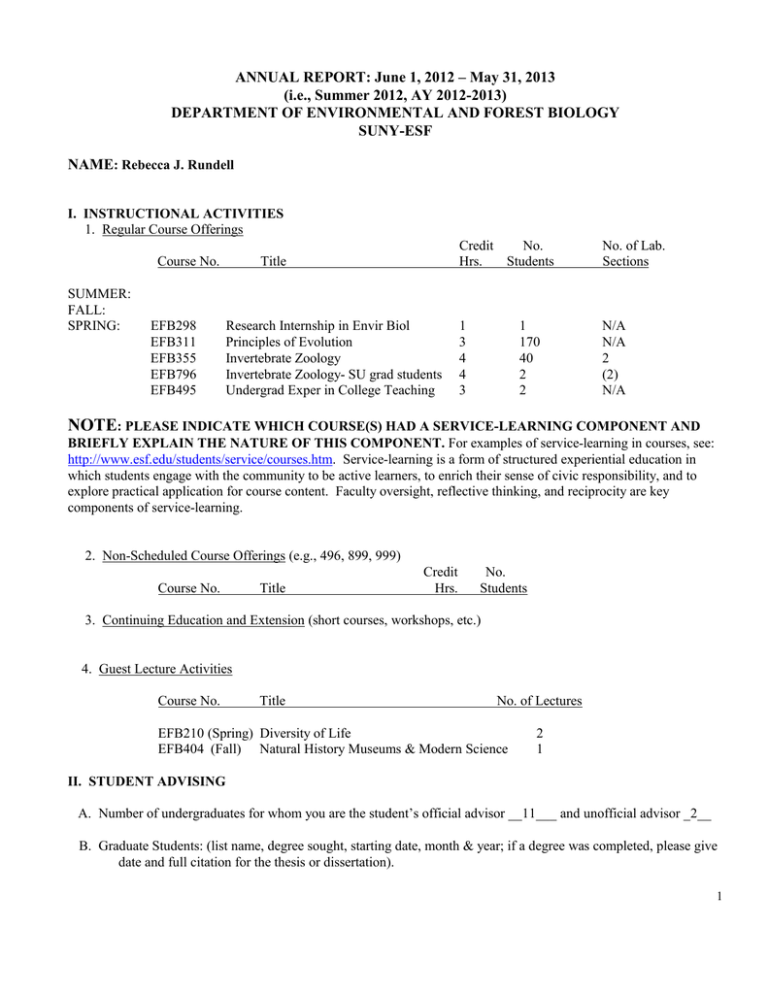
ANNUAL REPORT: June 1, 2012 – May 31, 2013 (i.e., Summer 2012, AY 2012-2013) DEPARTMENT OF ENVIRONMENTAL AND FOREST BIOLOGY SUNY-ESF NAME: Rebecca J. Rundell I. INSTRUCTIONAL ACTIVITIES 1. Regular Course Offerings Course No. SUMMER: FALL: SPRING: EFB298 EFB311 EFB355 EFB796 EFB495 Title Research Internship in Envir Biol Principles of Evolution Invertebrate Zoology Invertebrate Zoology- SU grad students Undergrad Exper in College Teaching Credit No. Hrs. Students No. of Lab. Sections 1 3 4 4 3 N/A N/A 2 (2) N/A 1 170 40 2 2 NOTE: PLEASE INDICATE WHICH COURSE(S) HAD A SERVICE-LEARNING COMPONENT AND BRIEFLY EXPLAIN THE NATURE OF THIS COMPONENT. For examples of service-learning in courses, see: http://www.esf.edu/students/service/courses.htm. Service-learning is a form of structured experiential education in which students engage with the community to be active learners, to enrich their sense of civic responsibility, and to explore practical application for course content. Faculty oversight, reflective thinking, and reciprocity are key components of service-learning. 2. Non-Scheduled Course Offerings (e.g., 496, 899, 999) Course No. Title Credit Hrs. No. Students 3. Continuing Education and Extension (short courses, workshops, etc.) 4. Guest Lecture Activities Course No. Title No. of Lectures EFB210 (Spring) Diversity of Life EFB404 (Fall) Natural History Museums & Modern Science 2 1 II. STUDENT ADVISING A. Number of undergraduates for whom you are the student’s official advisor __11___ and unofficial advisor _2__ B. Graduate Students: (list name, degree sought, starting date, month & year; if a degree was completed, please give date and full citation for the thesis or dissertation). 1 MAJOR PROFESSOR Ms. Jessica Lynn Miller, MPS EFB/Conservation Biology, January 2013 CO-MAJOR PROFESSOR MEMBER, STEERING COMMITTEE (other than those listed above) Mr. Stefan Karkuff, MS, Conservation Biology CHAIRMAN OR READER ON THESIS EXAMS, ETC. Ms. Mariana Nava Lopez, Doctoral Candidacy Examination III. RESEARCH COMPLETED OR UNDERWAY A. Departmental Research (unsupported, boot-legged; title - % time spent) - Molecular phylogenetics and comparative morphology of kalyptorhynch flatworms, unsupported, 5% - Polyploidy (whole genome duplication) in animals, using comparative genomics and bioinformatics approaches, unsupported, 5% - Conservation status and formal listing of Palau land snails on the IUCN Red List, unsupported, 5% - Evolution, conservation and biogeography of Belau endemic land snails, unsupported, 5% B. 1. Grant-supported Research (source, subject, amount - total award and current year, award period starting and ending dates; list graduate research assistants supported by each grant) 2. Research Proposals pending (include information as in B.1., above). USFWS Endangered Species Great Lakes Restoration Initiative (GLRI), “Removing the threat of stochastic extinction for the Chittenango ovate amber snail: A collaborative captive propagation effort to develop ex situ populations in New York State,” $100,000, 9/1/2013 – 8/31/2016; partial support for Ms. Cody Gilbertson (accepted incoming MS Conservation Biology student) 3. Research Proposals submitted, but rejected (include information as in B.1, above) IV. PUBLICATIONS (Full bibliographic citation, i.e., do not use "with Jones," or "Jones, et al."; please list only publications published, in press, or actually submitted during this reporting period --- do not list manuscripts in preparation). A. Refereed Publications O’Foighil, D. and Rundell, R.J. 2012. Partula calypso. In: IUCN 2012. IUCN Red List of Threatened Species. Version 2012.2. www.iucnredlist.org. 2 O’Foighil, D. and Rundell, R.J. 2012. Partula leucothoe. In: IUCN 2012. IUCN Red List of Threatened Species. Version 2012.2. www.iucnredlist.org. O’Foighil, D. and Rundell, R.J. 2012. Partula thetis. In: IUCN 2012. IUCN Red List of Threatened Species. Version 2012.2. www.iucnredlist.org. Rundell, R.J. 2012. Aaadonta angaurana. In: IUCN 2012. IUCN Red List of Threatened Species. Version 2012.2. www.iucnredlist.org. Rundell, R.J. 2012. Aaadonta constricta. In: IUCN 2012. IUCN Red List of Threatened Species. Version 2012.2. www.iucnredlist.org. Rundell, R.J. 2012. Aaadonta constricta ssp. babelthuapi. In: IUCN 2012. IUCN Red List of Threatened Species. Version 2012.2. www.iucnredlist.org. Rundell, R.J. 2012. Aaadonta constricta ssp. constricta. In: IUCN 2012. IUCN Red List of Threatened Species. Version 2012.2. www.iucnredlist.org. Rundell, R.J. 2012. Aaadonta constricta ssp. komakanensis. In: IUCN 2012. IUCN Red List of Threatened Species. Version 2012.2. www.iucnredlist.org. Rundell, R.J. 2012. Aaadonta constricta ssp. kororensis. In: IUCN 2012. IUCN Red List of Threatened Species. Version 2012.2. www.iucnredlist.org. Rundell, R.J. 2012. Aaadonta fuscozonata. In: IUCN 2012. IUCN Red List of Threatened Species. Version 2012.2. www.iucnredlist.org. Rundell, R.J. 2012. Aaadonta fuscozonata ssp. depressa. In: IUCN 2012. IUCN Red List of Threatened Species. Version 2012.2. www.iucnredlist.org. Rundell, R.J. 2012. Aaadonta fuscozonata ssp. fuscozonata. In: IUCN 2012. IUCN Red List of Threatened Species. Version 2012.2. www.iucnredlist.org. Rundell, R.J. 2012. Aaadonta irregularis. In: IUCN 2012. IUCN Red List of Threatened Species. Version 2012.2. www.iucnredlist.org. Rundell, R.J. 2012. Aaadonta kinlochi. In: IUCN 2012. IUCN Red List of Threatened Species. Version 2012.2. www.iucnredlist.org. Rundell, R.J. 2012. Aaadonta pelewana. In: IUCN 2012. IUCN Red List of Threatened Species. Version 2012.2. www.iucnredlist.org. Rundell, R.J. 2012. Coneuplecta turrita. In: IUCN 2012. IUCN Red List of Threatened Species. Version 2012.2. www.iucnredlist.org. Rundell, R.J. 2012. Diplommatina alata. In: IUCN 2012. IUCN Red List of Threatened Species. Version 2012.2. www.iucnredlist.org. Rundell, R.J. 2012. Diplommatina aurea. In: IUCN 2012. IUCN Red List of Threatened Species. Version 2012.2. www.iucnredlist.org. Rundell, R.J. 2012. Diplommatina crassilabris. In: IUCN 2012. IUCN Red List of Threatened Species. Version 2012.2. www.iucnredlist.org. Rundell, R.J. 2012. Diplommatina gibboni. In: IUCN 2012. IUCN Red List of Threatened Species. Version 2012.2. www.iucnredlist.org. Rundell, R.J. 2012. Diplommatina inflatula. In: IUCN 2012. IUCN Red List of Threatened Species. Version 2012.2. www.iucnredlist.org. Rundell, R.J. 2012. Diplommatina lamellata. In: IUCN 2012. IUCN Red List of Threatened Species. Version 2012.2. www.iucnredlist.org. Rundell, R.J. 2012. Diplommatina lutea. In: IUCN 2012. IUCN Red List of Threatened Species. Version 2012.2. www.iucnredlist.org. Rundell, R.J. 2012. Diplommatina pyramis. In: IUCN 2012. IUCN Red List of Threatened Species. Version 2012.2. www.iucnredlist.org. Rundell, R.J. 2012. Diplommatina ringens. In: IUCN 2012. IUCN Red List of Threatened Species. Version 2012.2. www.iucnredlist.org. Rundell, R.J. 2012. Elasmias ovulatum. In: IUCN 2012. IUCN Red List of Threatened Species. Version 2012.2. www.iucnredlist.org. 3 Rundell, R.J. 2012. Hungerfordia pelewensis. In: IUCN 2012. IUCN Red List of Threatened Species. Version 2012.2. www.iucnredlist.org. Rundell, R.J. 2012. Kororia palaensis. In: IUCN 2012. IUCN Red List of Threatened Species. Version 2012.2. www.iucnredlist.org. Rundell, R.J. 2012. Kubaryia pilikia. In: IUCN 2012. IUCN Red List of Threatened Species. Version 2012.2. www.iucnredlist.org. Rundell, R.J. 2012. Liravidena lacerata. In: IUCN 2012. IUCN Red List of Threatened Species. Version 2012.2. www.iucnredlist.org. Rundell, R.J. 2012. Omphalotropis cheynei. In: IUCN 2012. IUCN Red List of Threatened Species. Version 2012.2. www.iucnredlist.org. Rundell, R.J. 2012. Palaeohelicina heterochroa. In: IUCN 2012. IUCN Red List of Threatened Species. Version 2012.2. www.iucnredlist.org. Rundell, R.J. 2012. Palaina albata. In: IUCN 2012. IUCN Red List of Threatened Species. Version 2012.2. www.iucnredlist.org. Rundell, R.J. 2012. Palaina chrysalis. In: IUCN 2012. IUCN Red List of Threatened Species. Version 2012.2. www.iucnredlist.org. Rundell, R.J. 2012. Palaina dimorpha. In: IUCN 2012. IUCN Red List of Threatened Species. Version 2012.2. www.iucnredlist.org. Rundell, R.J. 2012. Palaina dohrni. In: IUCN 2012. IUCN Red List of Threatened Species. Version 2012.2. www.iucnredlist.org. Rundell, R.J. 2012. Palaina moussoni. In: IUCN 2012. IUCN Red List of Threatened Species. Version 2012.2. www.iucnredlist.org. Rundell, R.J. 2012. Palaina patula. In: IUCN 2012. IUCN Red List of Threatened Species. Version 2012.2. www.iucnredlist.org. Rundell, R.J. 2012. Palaina albata. In: IUCN 2012. IUCN Red List of Threatened Species. Version 2012.2. www.iucnredlist.org. Rundell, R.J. 2012. Palaina platycheilus. In: IUCN 2012. IUCN Red List of Threatened Species. Version 2012.2. www.iucnredlist.org. Rundell, R.J. 2012. Palaina pupa. In: IUCN 2012. IUCN Red List of Threatened Species. Version 2012.2. www.iucnredlist.org. Rundell, R.J. 2012. Palaina pusilla. In: IUCN 2012. IUCN Red List of Threatened Species. Version 2012.2. www.iucnredlist.org. Rundell, R.J. 2012. Palaina rubella. In: IUCN 2012. IUCN Red List of Threatened Species. Version 2012.2. www.iucnredlist.org. Rundell, R.J. 2012. Palaina strigata. In: IUCN 2012. IUCN Red List of Threatened Species. Version 2012.2. www.iucnredlist.org. Rundell, R.J. 2012. Palaina striolata. In: IUCN 2012. IUCN Red List of Threatened Species. Version 2012.2. www.iucnredlist.org. Rundell, R.J. 2012. Palaina wilsoni. In: IUCN 2012. IUCN Red List of Threatened Species. Version 2012.2. www.iucnredlist.org. Rundell, R.J. 2012. Palaua minor. In: IUCN 2012. IUCN Red List of Threatened Species. Version 2012.2. www.iucnredlist.org. Rundell, R.J. 2012. Palline notera. In: IUCN 2012. IUCN Red List of Threatened Species. Version 2012.2. www.iucnredlist.org. Rundell, R.J. 2012. Pleuropoma pelewensis. In: IUCN 2012. IUCN Red List of Threatened Species. Version 2012.2. www.iucnredlist.org. Rundell, R.J. 2012. Pseudopalaina polymorpha. In: IUCN 2012. IUCN Red List of Threatened Species. Version 2012.2. www.iucnredlist.org. Rundell, R.J. 2012. Pupina difficilis. In: IUCN 2012. IUCN Red List of Threatened Species. Version 2012.2. www.iucnredlist.org. 4 Rundell, R.J. 2012. Semperdon kororensis. In: IUCN 2012. IUCN Red List of Threatened Species. Version 2012.2. www.iucnredlist.org. Rundell, R.J. 2012. Semperdon uncatus. In: IUCN 2012. IUCN Red List of Threatened Species. Version 2012.2. www.iucnredlist.org. Rundell, R.J. 2012. Semperdon xyleborus. In: IUCN 2012. IUCN Red List of Threatened Species. Version 2012.2. www.iucnredlist.org. Rundell, R.J. 2012. Succinea philippinica. In: IUCN 2012. IUCN Red List of Threatened Species. Version 2012.2. www.iucnredlist.org. Rundell, R.J. 2012. Truncatella guerinii. In: IUCN 2012. IUCN Red List of Threatened Species. Version 2012.2. www.iucnredlist.org. Rundell, R.J. 2012. Videna electra. In: IUCN 2012. IUCN Red List of Threatened Species. Version 2012.2. www.iucnredlist.org. Rundell, R.J. 2012. Videna oleacina. In: IUCN 2012. IUCN Red List of Threatened Species. Version 2012.2. www.iucnredlist.org. Rundell, R.J. 2012. Videna pagodula. In: IUCN 2012. IUCN Red List of Threatened Species. Version 2012.2. www.iucnredlist.org. Rundell, R.J. 2012. Videna pumila. In: IUCN 2012. IUCN Red List of Threatened Species. Version 2012.2. www.iucnredlist.org. Rundell, R.J. and Leander, B.S. Submitted. Molecular phylogeny of kalyptorhynch turbellarians (Platyhelminthes: Rhabdocoela), including descriptions of five meiofaunal species from the northeastern Pacific Ocean. Invertebrate Biology. B. Non-refereed Publications C. Papers Presented at Science Meetings (give title, date, occasion, and location) “Linking research and teaching through museum collections and natural objects,” 12 October 2013, Integrative STEM Learning: Pedagogy and Partners Conference, Trinity University and Howard Hughes Medical Institute, San Antonio, Texas D. Public Service Presentations (lectures, seminars, etc. to and for the public; give group or occasion, date(s), and attendance) “Evolution and conservation of the rock- and leaf litter-dwelling land snails of Belau (Republic of Palau, Oceania),” Departmental of Ecology and Evolutionary Biology, Cornell University, Departmental Seminar, 11 March 2013, 30 “Evolution and conservation of the land snails of Belau (Republic of Palau, Oceania) and future directions,” Adaptive Peaks Seminar, SUNY-ESF, 18 October 2012, 50 “Diversification and conservation of the rock- and leaf litter-dwelling land snails of Belau (Republic of Palau, Oceania),” HeiserFest: Symposium in Honor of Dr. John B. Heiser, Shoals Marine Laboratory and Seacoast Science Center, Rye, New Hampshire, 1 September 2012, 50 V. PUBLIC SERVICE A. Funded Service (include consulting activities) 1. Government Agencies (Federal, State, Local): 5 2. Industrial and Commercial Groups, etc. B. Unfunded Service to Governmental Agencies, Public Interest Groups, etc. Served as a mentor for female 9th grade student interested in a career in biology; North Syracuse Central School District Humanities Course Career Enrichment Program Mark-recapture field study of the federally endangered Chittenango ovate amber snail, U.S. Fish and Wildlife Service Specialist, IUCN/Species Survival Commission, Mollusc Specialist Group Convened a celebration of International Darwin Day. The Moon Library/EFB311 event, featuring student-produced mini-posters and other Darwin-related information was advertised on the International Darwin Day Foundation website: darwinday.org. This was the only publicized Darwin Day event in Syracuse. VI. PROFESSIONAL DEVELOPMENT A. Professional Honors and Awards (for teaching, research, outreach, etc.) Nominated as Research Associate, Carnegie Museum of Natural History, Pittsburgh, Pennsylvania Nominated as Research Associate, Paleontological Research Institution, Ithaca, New York B. 1. Activities in Professional Organizations (offices held, service as chairman, member, participant or consultant) 2. Professional Society Membership American Malacological Society Paleontological Research Institution Palau Conservation Society Society for Integrative and Comparative Biology 3. Other Professional Activities a. Editorial activity Journal (s) Responsibility Other (books, symposia, etc.) b. Reviewer Journal(s) Biodiversity and Conservation No. of manuscripts 1 6 Biological Invasions Marine Biology Research Molecular Ecology Molecular Phylogenetics and Evolution Pacific Conservation Biology Zoological Journal of the Linnean Society Zootaxa Agency National Science Foundation 1 1 1 1 1 1 1 No. of proposals 2 Other c. Participation (workshops, symposia, etc.) Name of workshop, etc. Evo-Day 2013: Novel Traits and Rapid Evolution Date Place 6 May 2013 Cornell University C. Further Education/Re-training Undertaken, Leaves, Workshops, etc. Writing Across the Curriculum; 19 October 2012; SUNY-ESF D. Foreign Travel (Where, When, Purpose) VII. ADMINISTRATIVE AND SERVICE RESPONSIBILITIES (include committee participation) A. Department-level Burgess Award, Committee Member B. College-level C. University-wide, including Research Foundation VIII. SUMMARY OF SIGNIFICANT ACTIVITIES AND ACCOMPLISHMENTS DURING THIS REPORTING PERIOD, ESPECIALLY THOSE MOST NOTEWORTHY AND RELATIVE TO THE COLLEGE’S AND DEPARTMENT’S MISSION. One paragraph on each of the following (i.e., three paragraphs total) would be most helpful: this past year, what have you done for our students, department/college, and self professionally? NOTE: The information in this section (along with the supporting specific information elsewhere in this report) should be your strongest case for being considered for a discretionary raise (when available), which I’ll continue to award based on your contributions to the department and college this reporting period. 7 Students: This spring I taught EFB311 Evolution and EFB355 Invertebrate Zoology (with two labs). Factoring in the students from my guest lectures in Weir’s Diversity of Life course and Folta’s Natural History Museums & Modern Science course, I taught over 400 ESF students this year. I took the assignment of teaching both Evolution and Invertebrate Zoology as an opportunity to incorporate the latest findings into both courses and infuse them with new ideas. In Evolution the students sharpened their critical reading and thinking skills by producing mini-posters based on the latest and most compelling research in evolutionary biology. We exhibited the posters at Moon Library to focus regional and campus attention on the central role of evolutionary biology as part of the International Darwin Day celebration. Our event was facilitated by Assistant Librarian and EFB Liaison Jessica Clemons and Director Stephen Weiter, and was publicized on the International Darwin Day Foundation website and featured in ESF News. Weiter said he heard lots of positive and appreciative comments about the posters and noticed that people were actually coming in and reading them. I plan to keep this part of the course in future years as a way to not only engage students with the reality of recent evolutionary research, but to bring students in close proximity to Moon Library’s critical intellectual resources. This year in Evolution I introduced two new texts: Doug Futuyma’s Evolution and Jerry Coyne’s Why Evolution is True. The latter author, a world-renowned evolutionary biologist and geneticist, generously agreed to participate in a live Skype chat with the students in April. Students asked questions based on the book or their own curiosity and quickly learned that Coyne does not shy away from perceived controversy. It was a great experience for the class and I think everyone would have stayed for hours longer, had we a longer class period. In both Evolution and Invertebrate Zoology I led field trips, which I believe are firsts for both courses. My main goal was to give students hands-on, visceral and unforgettable experiences with evolution and deep time. There were two weekend trips for the Evolution course and one for the Inverts course. We stopped at two Devonian fossil sites, where students learned some local geology, ecology and evolution and collected their own fossils. Each student came away with a physical reminder of deep time, and students uncovered some excellent specimens including cephalopods and large, whole trilobites. After fossil collecting we headed to the Museum of the Earth in Ithaca for an hour-long program by staff scientists on human evolution, conservation and genetics, or in the case of the inverts course a behind the scenes collections tour. Following the program students checked out Museum of the Earth exhibits, which include everything from Burgess Shale specimens to exquisite Paleozoic fossils, all the way up to a fully articulated mastodon skeleton. In both Evolution and Inverts courses I passed around specimens from my own collections and from our invaluable Invertebrates Teaching Collection. This year I started the Evolution course with a piece of dinosaur bone and ended it with a fossil ear bone from a whale. I plan to incorporate more specimens in my lectures in the future, since they generate great questions and curiosity from the students, as well as memory of the material. The main experimental component of my Inverts course this year was using the flip classroom technique in lab, or as I like to call it, “invert-ed” classroom. Rather than directly teaching each dissection, students chose a dissection to lead via lottery on the first day of class. The TAs and I fed students information (videos, illustrations, etc.), and then on the lab day they taught that lab segment themselves. This pilot teaching project was well received and I plan to continue it. My main goals for this are to engage the class in questions and discussion and discover future New York State science teachers. In Inverts we also introduced several marine tanks, including a coldwater marine tank system that will enable us to bring in more northeast marine taxa, allowing students to learn our “local” biota. We have built a mangrove jelly flow-through tank system and we are also building a small pseudokreisel (circulating jellyfish tank) that will allow students to better interact with some of the most charismatic invertebrates. Live animals are so important for getting students excited about invertebrate animals and these tanks not only help to keep the animals alive, but also give students practical experience in aquatics. Although this course is certainly a work in progress, one of my students recently told me that Inverts has been his favorite course so far at ESF. This inspires me to keep building it for future undergrad and grad students. With respect to graduate students in my lab, I took on one MPS student in Conservation Biology this year, and will welcome a new MS Con Bio student in the fall. I am cultivating a couple prospective students for the subsequent year. 8 Department/College: I very much appreciated the many warm and friendly colleagues who welcomed me to the department this year and helped balance the impacts of multifarious construction projects in Illick. I have not yet been extensively involved in departmental service, but served on the Burgess Award committee and presented an award for the Conservation Biology major at the EFB ceremony on graduation day. Self: I am building my lab, which is largely focused on: 1) conservation research on local/northeastern and Pacific nonmarine snails, and 2) diversification and correlates of species diversity in species-rich and understudied invertebrate taxa. One prominent goal on the conservation management side of conservation biology is to thwart the extinction of species. Our local geographically restricted land snail Novisuccinea chittenangoensis allows us the opportunity to attempt this, and in so doing the species might inform conservation of other severely impacted riparian snails elsewhere in North America. Following the Species Action Plan (and building on the work of other EFB faculty), through a collaboration with USFWS, I have submitted a grant that would allow us to breed N. chittenangoensis in captivity and partially support an incoming graduate student whose Master’s project will be focused on conservation of this species. In the Pacific/Oceania region I have worked closely with the IUCN and land snail colleagues to assess and publish the conservation status and geographic range for 60 species and subspecies of Pacific Island land snails. This is the first time such a monumental effort has been undertaken, particularly for the biota of western Pacific islands. It provides a critical foundation for my future conservation efforts in the region, which include understanding how extinction risk is distributed within Pacific biotas. While some of our most species-rich invertebrate groups are rapidly going extinct, we still know relatively little about how these animals evolved. Reconstructing diversification and biogeographical patterns for Micronesian land snails, and Belau species in particular, is a major focus of my work and will resume as I finish cleaning up and putting together my lab this summer. In the meantime I have continued my research on the molecular phylogeny and morphology of marine meiofauna (microscopic interstitial invertebrates). I have also begun working with an undergrad interested in freshwater meiofauna research in the Adirondacks, which will help us build a local component to understanding invertebrate diversification patterns and ecological correlates for diversity. A related interest is to study larger-scale causes of speciation and bursts of diversification. Thus I have also continued my collaboration on whole genome duplication in animals, using computational facilities at University of Arizona. IX. A. FUTURE PLANS, AMBITIONS, AND POTENTIAL CONTRIBUTIONS FOR YOUR OWN PROFESSIONAL DEVELOPMENT AND THE ENHANCEMENT OF THE PROGRAM IN ENVIRONMENTAL AND FOREST BIOLOGY (brief summary) By building my lab and working with students I plan to: 1) Establish myself as the authority on land snail evolution, ecology and conservation in Micronesia with an emphasis on Belau (Republic of Palau). 2) Nurture Belau and its biota as both exemplars of evolution and Pacific conservation, through my developing research program and by forging and strengthening relationships with people and organizations locally in the Republic of Palau. 3) Investigate potential educational and conservation-related needs and opportunities in the Republic of Palau and Federated States of Micronesia and seek to address these as appropriate, working closely with local Micronesian and ESF colleagues. 4) Find ways to both understand and thwart land snail extinctions in Micronesia and northeastern North America, working closely with local agencies and stakeholders. 5) Incorporate community ecology, morphology, geographical range and genomic data more fully into my local and Pacific island-focused research. 6) Develop a graduate course in macroevolution that enhances ESF students’ understanding and appreciation for some of the big questions in evolutionary biology (e.g. causes and consequences of adaptive radiation and mass extinction events), which in many cases directly intersect with ecology and conservation biology. 9 B. PROJECTED ACTIVITIES FOR NEXT YEAR 1. Summer 2013 a. Course(s) to be offered b. Proposed research activity - Submit NSF CAREER grant (due 22 July) - Get research lab up to full operation - Undergraduate mentorship and collaboration on freshwater meiofauna research in the Adirondacks, with the aim of collecting data for a future undergraduate research project and preliminary data for a grant - Undergraduate mentor for research internship at the Riverhead Foundation for Marine Research and Preservation - Undergraduate participation in Ni-U compound microscope training with Nikon specialists, for their future applications in undergraduate research and the microscopy minor - Graduate student mentor for research internship at Rosamond Gifford Zoo - Specimen-based research on Belau snails at Field Museum of Natural History (Chicago, Illinois) - Molecular phylogenetics of Belau snails; collect and incorporate Merir data - Begin diplommatinid species descriptions - Bring together Belau conservation status data for ms. - Collect phylogenetic and morphological data for Belau endodontoid pilot project for future grant - Collaboration with prospective graduate student on phylogeny and isolation by distance ms. using Belau data - Collaboration on animal whole genome duplication dataset (remote; University of Arizona) - Collaboration with prospective graduate student on phylogenetic correlates of co-occurrence ms. - Collaboration with incoming graduate student on Chittenango ovate amber snail project: laying groundwork and building specimen base for phase one of captive propagation project c. University, professional society, and public service - Consulting on invertebrate conservation and invertebrate-focused education programs at the Cayuga Nature Center (a 75-acre forest in Ithaca, NY) - University teaching service: Working with work-study undergraduate student on generating collections for coldwater aquarium system for use in invertebrates-based teaching (e.g. Invertebrate Zoology and Marine Ecology) - University teaching service: Working with two undergraduates on completing the jellyfish pseudokreisel for Invertebrate Zoology 2. Fall Semester 2013 a. Course(s) to be offered EFB298 Research Internship in Envir Biol EFB498 Research Problems in EFB EFB899 Master’s Thesis Research Credits 3 1-3 No. of students 1 2 1 b. Proposed research activity Field research in the Republic of Palau, including igniting potential research/funding collaboration with Palau Conservation Society Terrestrial Conservation Officers and Education Dept. 10 Mentorship and collaboration with new MS Conservation Biology graduate student Ms. Cody Gilbertson on conservation and captive propagation of Chittenango ovate amber snail c. University, Professional society, and public service Working with the U.S. Fish and Wildlife Service on preventing the extinction of the federally endangered Chittenango ovate amber snail 3. Spring Semester 2014 a. Course(s) to be offered EFB298 EFB311 EFB355 EFB796 EFB495 EFB498 Research Internship in Envir Biol Principles of Evolution Invertebrate Zoology Invertebrate Zoology- grad students Undergrad Exper in College Teaching Research Problems in EFB b. Proposed research activity - continue work on summer 2013 projects and mss. - continue sorting specimens and data from fall 2013 field work - continue mentorship of undergraduate and graduate research students c. University, professional society, and public service 11
